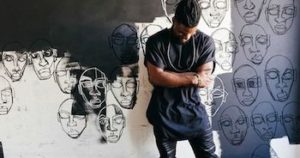
On this date, the Registry examines Black art in America. Painting, carving, graphic arts, and crafts were created by people of African descent in the United States and influenced by Black, African, and African American culture.
During America's early years, between the 16th and the early 18th century, Black art in American art had many forms and definitions. A small drum, wrought-iron figures, ceramic "face" vessels, and some domestic architecture found among enslaved Black communities in the Antebellum South are similar to comparable crafts, objects, and structures of West and Central Africa. In contrast, black artisans created art in a Western European fashion despite occasional portrayals of black subjects.
Some sculptors and landscape artists referenced Black American social conditions transcending race and class politics from the American Civil War years through the Post-Reconstruction period. Yet, the difficulty these artists grappled with at various points in their careers justified the African American designation of their work.
A similar political/apolitical junction is present in the work and lives of artists working between 1865 and 1900. Painters created moody scenes of white-on-black violence that characterized Black lives at the end of the century. In contrast, the seamstress Harriet Powers, Athens, Georgia, created at least two powerful Bible quilts similar to West African textile arts, especially the cloth trim from the Akan and Fon peoples. In the first two decades of the twentieth century, painters and sculptors of distinguished (and affluent) Black Americans were evident.
In the journal The Voice of the Negro Artist, John Henry Adams, Jr. created dozens of finely drawn African American portraits. In the works of the sculptor Meta Warrick Fuller, topics such as emancipation would be important for artists and intellectuals in the coming years. The social and political anxieties that many blacks felt just after migrations softened World War I to the urban North. Relief from the old South helped create the New Negro Arts Movement or Harlem Renaissance. The collective result focused on African Americans, their art, and a larger modernist vision. The pages of The Crisis, Opportunity, New Masses, and other reviews of the 1920s and 1930s helped to spread Harlem Renaissance imagery. The works of James Lesesne Wells, Albert Alexander Smith, and Aaron Douglas were among the published art.
During the Depression and World War II years, many artists in the 1930s made representations under the Federal Arts Projects of the Works Project Administration. These artists had not attended art school, and their works were often unsophisticated. In the final years of the Federal Arts Projects, several painters emerged out of obscurity and into national prominence. Others also achieved a measure of success in the larger world of art, often fusing the style preferences of the day with the artisan’s fondness for selected black subjects. The balancing act between race awareness in art and visual assimilation into the white culture was torn away by several artists after World War II.
The works connected to Africa, Black America, and the evolving American Civil Rights movement spotlighted a different definition of what was then described as "modern Negro art." In conjunction with the late 1950s racial justice boycotts, lunch-counter sit-ins, and attacks on Blacks by angry whites, these works took on even greater power in communicating the aspirations and dreams of African Americans. A sense of cultural authority became the benchmark for the late 1960s and early 70s Black Arts Movement. During this period, Black writers, performing artists, and visual artists made Black culture and the political struggles of Black people worldwide their raison d'être.

Slogans like Black is Beautiful and Black Power and the development of jazz and "soul" music became the soundtrack for many visual artworks. Some examples came through the Chicago-based Black artist collective AFRI-COBRA, which added African textile-inspired, mixed-media works and influential art manifestos that helped organize expositions of Black artists in Africa and North America. Many artists whose careers extended back 30 years resurfaced with a renewed sense of racial and political solidarity.
These advancements were made more emphatic by artists like the Washington painter Alma Thomas, who, at the age of 80, was the first Black woman to have a solo exhibition at New York's Whitney Museum of American Art in 1972. Artists and audiences grew more acquainted with the diversity of expressions of Black culture. Thus, the number of artists and works operating under the mandate of African American art increased.
By the mid-to-late 1980s, earlier definitions of African American art were replaced with the postmodernist belief of art-as-performance, the critical study of art and society through one's work, and the test of identity, geography, and history. By 1975, sculptures of Black hair, food, artifacts, and the like commented on Black identity.
Cartoon-like paintings that poked fun at the art establishment and performances that placed racism at the center of art matters helped create different visual standards in modern art. This inventive group includes sculptors, photographers, visual artists, painters, and conceptualists. Through the installation of 21st-century art, we have questioned American history and the psychology of racism so that their display can no longer be viewed like the past. Through the works of Artis Lane, Jean-Michel Basquiat, Kara Walker, and others, they continue to speak for history, culture, and heritage.
Voices Narratives.The Arts.AAREG
A History of African American Artist from 1792 to present
by Romare Bearden & Harry Henderson
Copyright 1993 by Romare Bearden & Harry Henderson
Pantheon Books, NY
ISBN 0-394-57016-2
The St. James Guide to Black Artist
Edited by Thomas Riggs
Copyright 1997, St. James Press, Detroit, MI
ISBN 1-55862-220-9